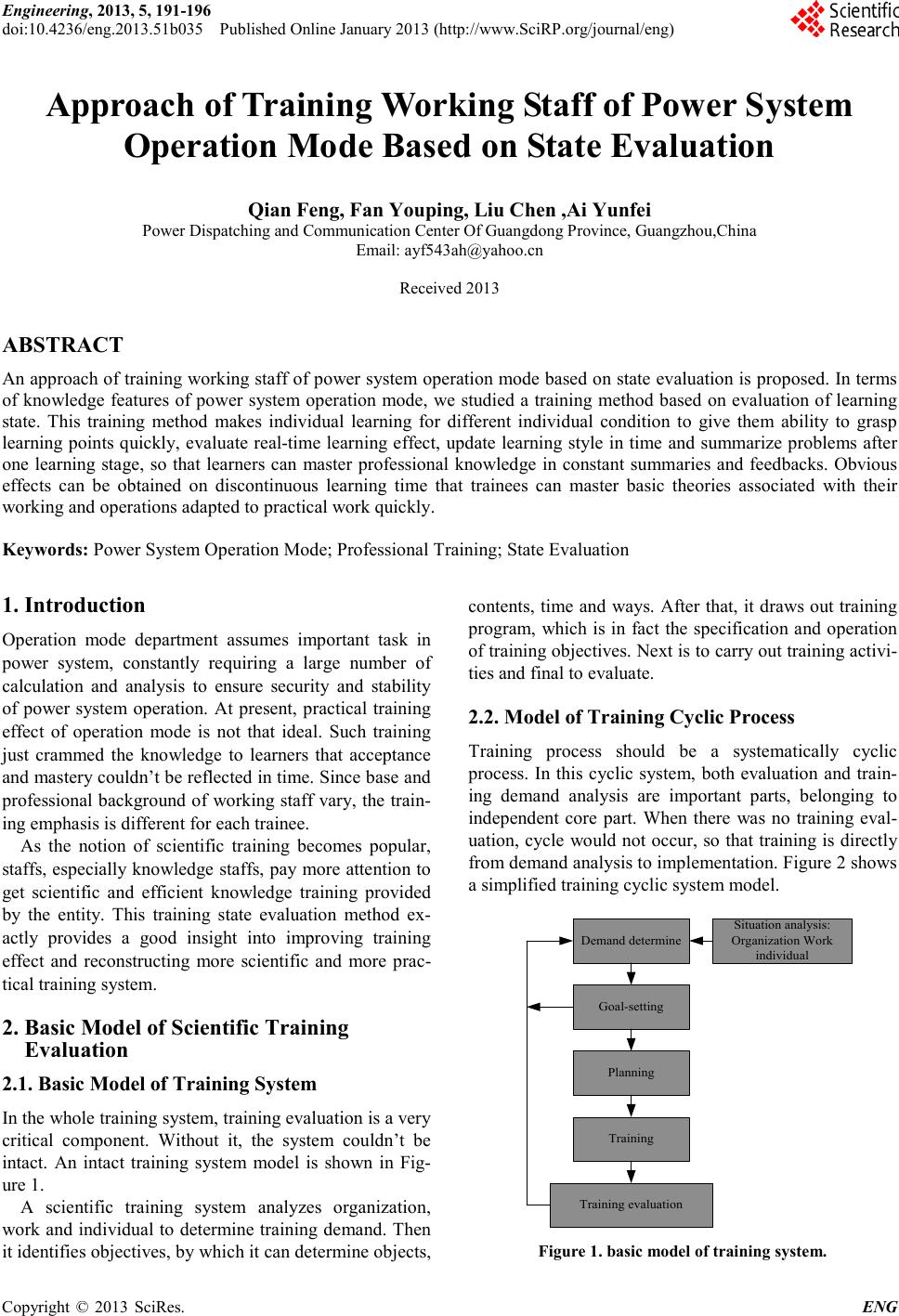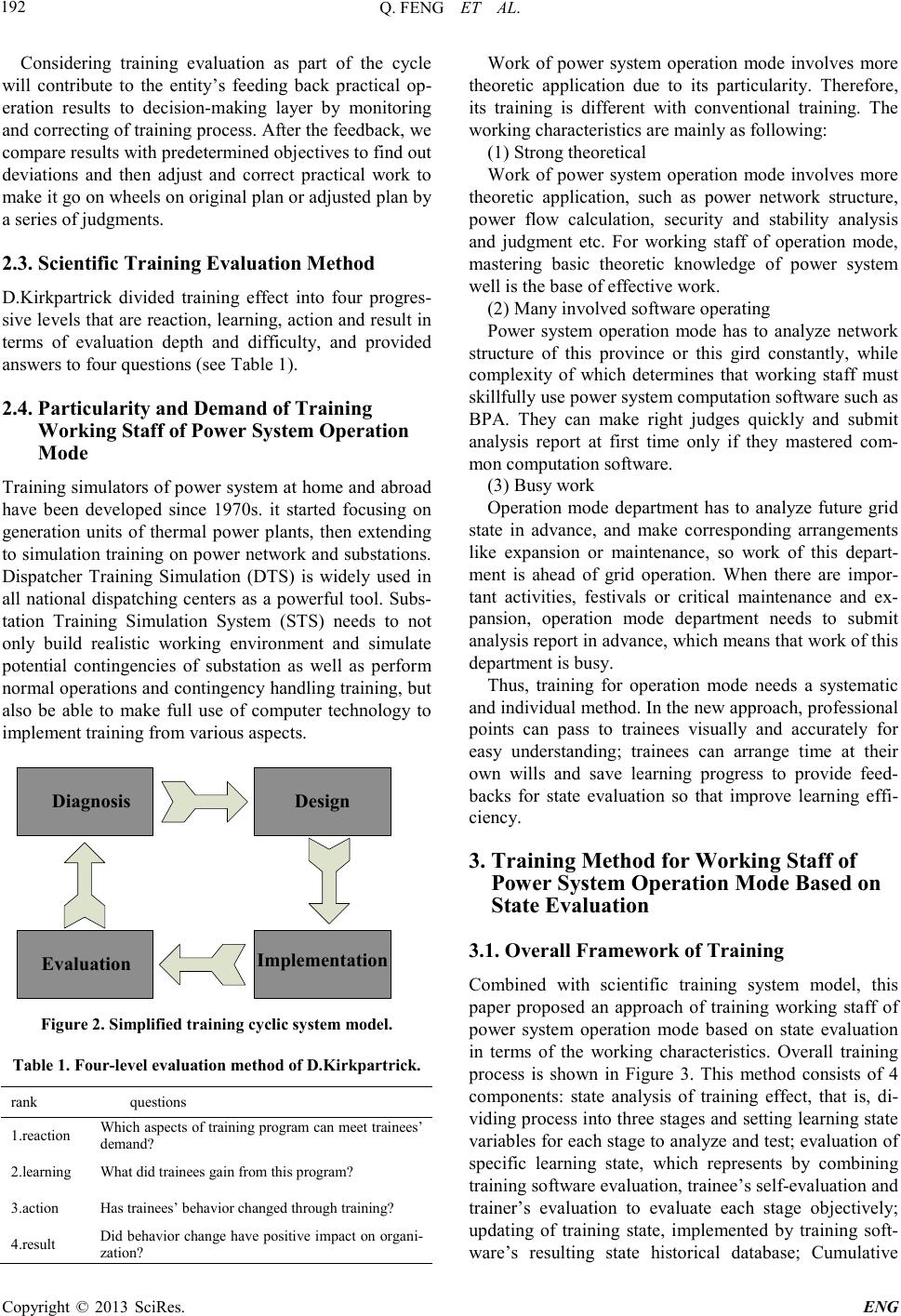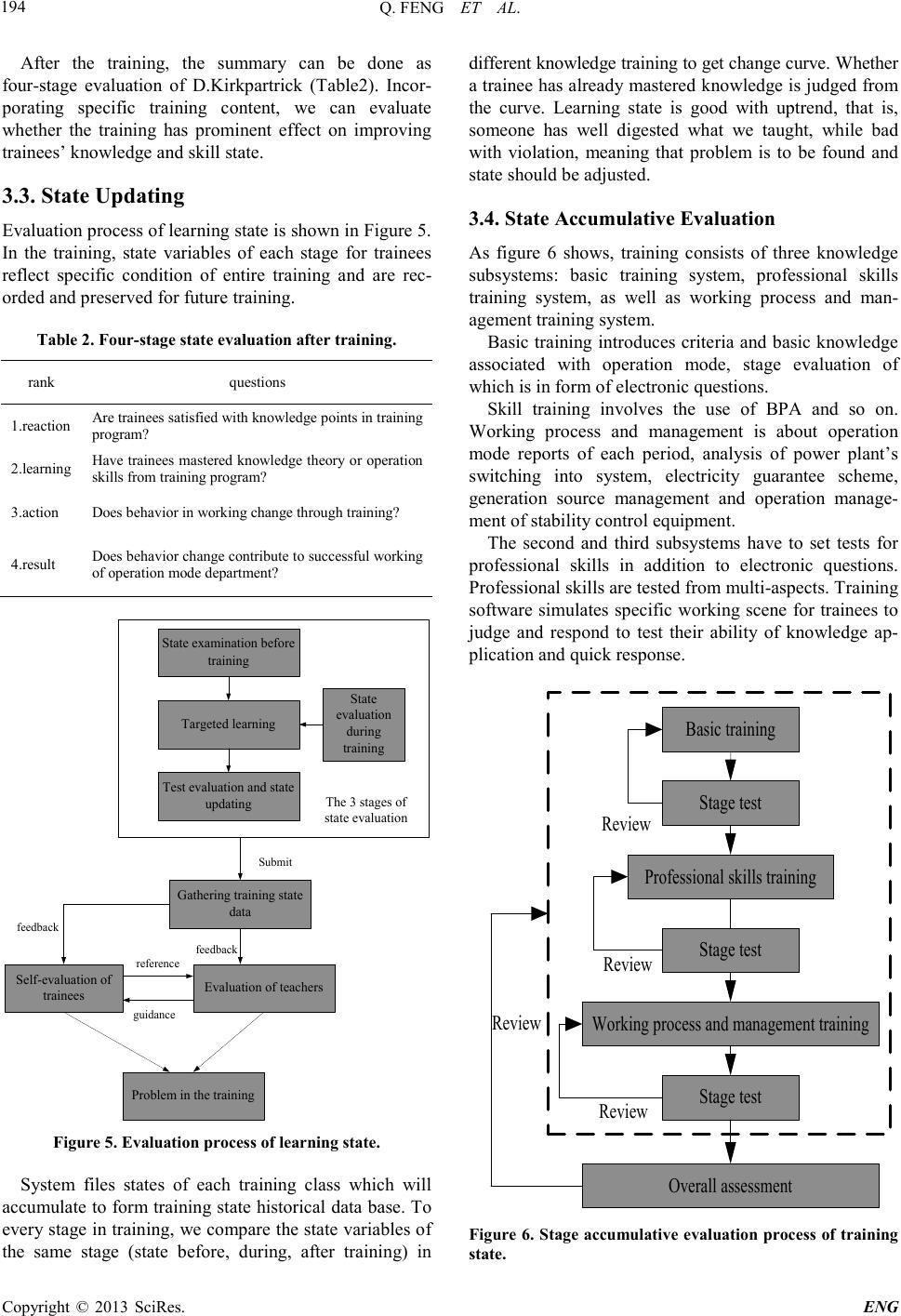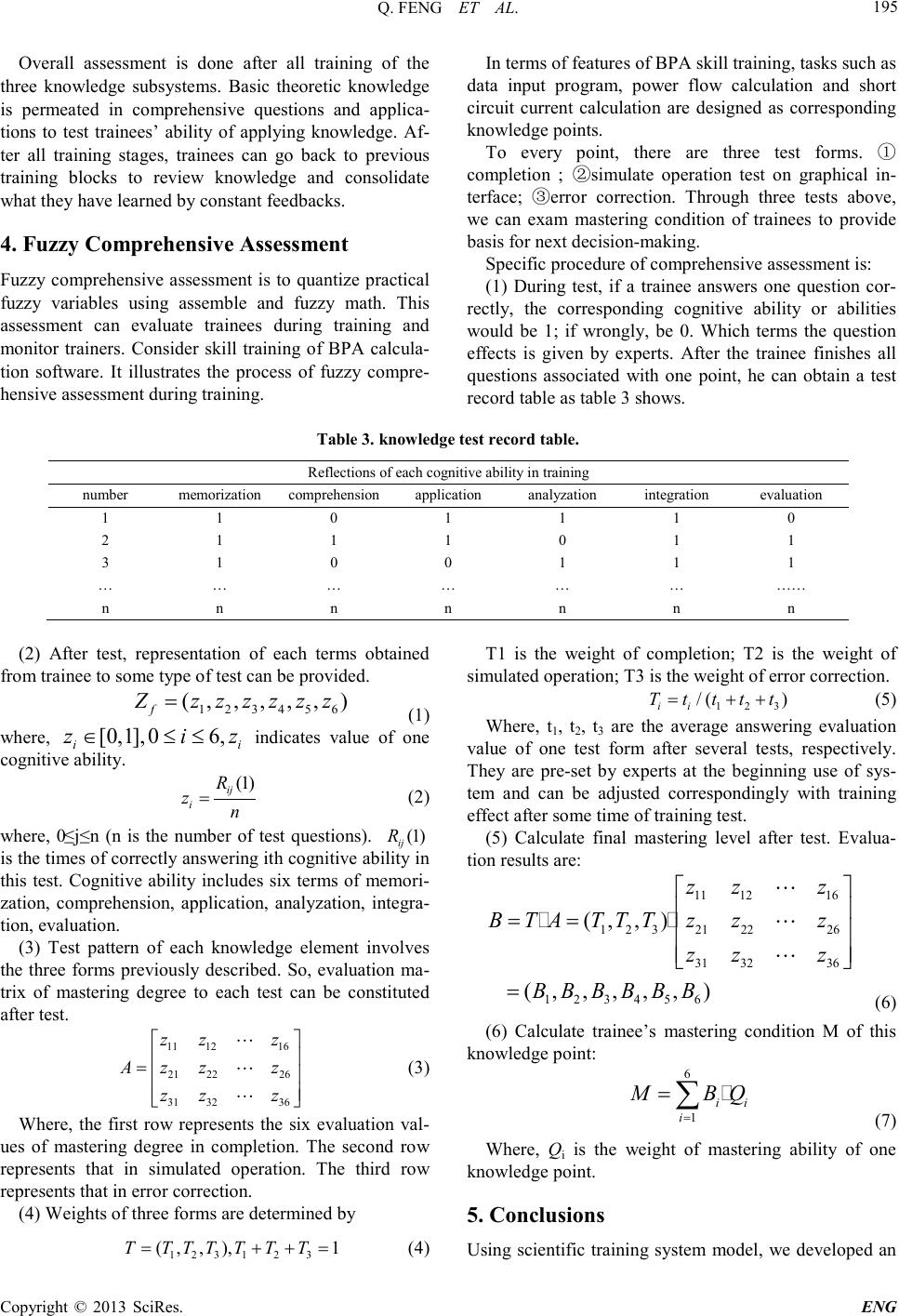Paper Menu >>
Journal Menu >>
 Engineering, 2013, 5, 191-196 doi:10.4236/eng.2013.51b035 Published Online January 2013 (http://www.SciRP.org/journal/eng) Copyright © 2013 SciRes. ENG Approach of Training Working Staff of Power System Operation Mode Based on State Evaluation Qian Feng, Fan Youping, Liu Chen ,Ai Yunfei Power Dispatching and Communication Center Of Guangdong Province, Guangzhou,China Email: ayf543ah@yahoo.cn Received 2013 ABSTRACT An approach of training working staff of power system operation mode based on state evaluation is proposed. In terms of knowledge features of power system operation mode, we studied a training method based on evaluation of learning state. This training method makes individual learning for different individual condition to give them ability to grasp learning points quickly, evaluate real-time learning effect, update learning style in time and summarize problems after one learning stage, so that learners can master professional knowledge in constant summaries and feedbacks. Obvious effects can be obtained on discontinuous learning time that trainees can master basic theories associated with their working and operations adapted to practical work quickly. Keywords: Power System Operation Mode; P rofessional Traini ng; Sta te E valuatio n 1. Introduction Operation mode department assumes important task in power system, constantly requiring a large number of calculation and analysis to ensure security and stability of power system operation. At present, practical training effect of operation mode is not that ideal. Such training just crammed the knowledge to learners that acceptance and mastery couldn’t be reflected in time. Since base and professional background of working staff vary, the train- ing emphasis is different for each trainee. As the notion of scientific training becomes popular, staffs, especia lly knowledge sta ffs, pa y more attention to get scientific and efficient knowledge training provided by the entity. This training state evaluation method ex- actly provides a good insight into improving training effect and reconstructing more scientific and more prac- tical training system. 2. Basic Model of Scientific Training Evaluation 2.1. Basic Model of Training System In the whole trainin g system, training e valuation is a very critical component. Without it, the system couldn’t be intact. An intact training system model is shown in Fig- ure 1. A scientific training system analyzes organization, work and individual to determine training demand. Then it identifies objectives, by which it can determine objects, contents, time and ways. After that, it draws out training program, which is in fact the specification and operation of training obj ectives. Ne xt is to carr y out training activi- ties and final to evaluate. 2.2. Model of Training Cyclic Process Training process should be a systematically cyclic process. In this cyclic system, both evaluation and train- ing demand analysis are important parts, belonging to independent core part. When there was no training eval- uation, cycle would not occur, so that training is directly from demand analysis to implementation. Figure 2 shows a simplified training cyclic system model. Demand determine Goal-setting Planning Training Training evaluation Situation analysis: Organization Work individual Figure 1 . b a s i c model of training sy stem.  Q. FENG ET AL. Copyright © 2013 SciRes. ENG 192 Considering training evaluation as part of the cycle will contribute to the entity’s feeding back practical op- eration results to decision-making layer by monitoring and correcting of training process. After the feedback, we compare results with predetermined objectives to find out deviations and then adjust and correct practical work to make i t go o n whe el s on o r igi na l p la n o r a d j uste d p lan by a series of judgments. 2.3. Scientific Training Evaluation Method D.Kirkpartrick divided training effect into four progres- sive levels that are reaction, learning, action and result in terms of evaluation depth and difficulty, and provided answers to four questions (see T able 1). 2.4. Particularity and Demand of Training Working Staff of Power System Operati on Mode Training simulators of po wer system at home and abroad have been developed since 1970s. it started focusing on generation units of thermal power plants, then extending to si mulation tr aini ng on powe r network a nd substa tions. Dispatcher Training Simulation (DTS) is widely used in all national dispatching centers as a powerful tool. Subs- tation Training Simulation System (STS) needs to not only build realistic working environment and simulate potential contingencies of substation as well as perform nor mal op era tions and c onti nge ncy ha ndli ng t raini ng, b ut also be able to make full use of computer technology to implement training fr om various aspects. Implementation Design Diagnosis Evaluation Figure 2 . S implified training cyclic system model. Table 1. Four-level evaluation met hod of D.K irkpartrick. rank questions 1.reaction Which aspect s of traini ng progr am can meet train ees’ demand? 2.learning What did traine es gain fr o m thi s p r o gram? 3.action Has trainees ’ behavior chan g ed through training? 4. r esult Did beh avior change have p ositive impac t on organi- zation? Work of power system operation mode involves more theoretic application due to its particularity. Therefore, its training is different with conventional training. The working characteristics are mainly as following: (1) Stro ng theore tic a l Work of power system operation mode involves more theoretic application, such as power network structure, power flow calculation, security and stability analysis and judgment etc. For working staff of operation mode, mastering basic theoretic knowledge of power system well is the base of effective work. (2) Many involved software operating Power system operation mode has to analyze network structure of this province or this gird constantly, while complexity of which determines that working staff must skillfully use power syst em c omputation software suc h as BPA. They can make right judges quickly and submit analysis report at first time only if they mastered com- mon computation software. (3) Busy work Operation mode department has to analyze future grid state in advance, and make corresponding arrangements like expansion or maintenance, so work of this depart- ment is ahead of grid operation. When there are impor- tant activities, festivals or critical maintenance and ex- pansion, operation mode department needs to submit anal ysis re p or t i n ad va nc e, whi ch mea ns t ha t wor k o f t hi s department is busy. Thus, training for operation mode needs a systematic and individual method. In the new approach, professional points can pass to trainees visually and accurately for easy understanding; trainees can arrange time at their own wills and save learning progress to provide feed- backs for state evaluation so that improve learning effi- ciency. 3. Training Method for Working Staff of Power System Operation Mode Based on State Evaluation 3.1. Overall Framework of Training Combined with scientific training system model, this paper proposed an approach of training working staff of power system operation mode based on state evaluation in terms of the working characteristics. Overall training process is shown in Figure 3. This method consists of 4 components: state analysis of training effect, that is, di- viding process into three stages and setting learning state variables for each stage to analyze and test; e valuation o f specific learning state, which represents by combining training software evaluation, trainee’s self-eval uat io n a nd trainer’s evaluation to evaluate each stage objectively; updating of training state, implemented by training soft- ware’s resulting state historical database; Cumulative  Q. FENG ET AL. Copyright © 2013 SciRes. ENG 193 assessment o f training state, i n other words, to divide the training into 4 stages to per form differe nt level of evalua- tion, respectively, and finally make total assessment. 3.2. Evaluation of Specific Learning State Evaluation of learning state is divided into three stages: state examination before learning, state evaluation during learning, state updating after learning. Distribution is as Figure 4 shows. 1) Sta te examination befor e training This stage includes two parts that are readiness exams of basic knowledge and practical skill. Since the basis varies, examining readiness of trainees can give a rough idea of their knowledge and skill base to make training pertinence. Demand determine Training target Planning Training Training evaluation Evaluation before training Requirement of the professional knowledge Learning foundation Historical databaseSave Save Figure 3 . Process of overal l training method. Learning state of trainees State examination before training State evaluation during trainingState updating after training Basic knowledge Practical skill Response state of trainees Learning effect state Knowledge and ability state Figure 4. Distr ibuti on of learni ng st a te. Readiness exam of basic knowledge is mainly about theoretic knowledge. Before training, we can know about knowledge readiness of trainees by a quick electronic test. Test content is knowledge points of courses to be taken, and test questions are harder as the question number in- creases. In the end, trainees’ readiness is graded accord- ing to their answers. Mastering level of knowledge de- cides the amount of energy they should pay to courses to be trained. If a trainee has already gotten corresponding professional knowledge base, he can jump this part. Readiness exam of practical skill is more complex. Because of the little ti me available for exam, this exam is mainly about self-test. Before training one skill, such as use of BPA and setting sheet formation of spare power automatic s witching device, trainees get fa miliar with the soft war e on t hemselves a nd se lf -eval uate their familia rity and proficiency. Self-test is done with software function blocks to let trainees judge their behavior. After test, the system will ask trainees to self-grade in terms of given levels, thus obtain the rank of skill readiness. System then provides purposeful training for each trainee by the self-test results. If someone has a good skill base and reaches a good mastering level, he can jump this part. 2) Sta te evalua tion during training Response state and learning effect state during training. In the training, trainees’ response reflects their learning effect. If they respond quickly and actively, they have a good learning state and are easy to accept knowledge; while if t he y re spond slo wl y, the y ha ve n’t full y ma ster ed the knowledge, so they need to continue consolidating what they have learned. In this stage, after single know- ledge point is taught, training system will pop up choice questions. Through trainees’ response condition and answering time, their response state can be provided to determine learning effect. If response to one point is slow and accuracy is not high, it demonstrates that the trainee has some difficulty in receiving this point and system will repeat it again more slowly. To each test, system will record corresponding state so that can evaluate learning state after training. 3) Sta te updating after training Overall test of entire knowledge module is needed af- ter training, which is a test with time limit. Simple basic knowledge has a short time limit, requiring trainees to give answers quickly at first time; difficult essay ques- tions and calculatio n questions also ha ve time li mits cor- responding to difficulty level, requiring trainees can master the points well and apply them and skills fast. Test result after training is measured with two variables that are total score and answering time. Although one may get a high score, if he gave answers near or on the time limit, he is demonstrated to just master for tempo- rary and system still suggests the trainee to consolidate after trainin g.  Q. FENG ET AL. Copyright © 2013 SciRes. ENG 194 After the training, the summary can be done as four-stage evaluation of D.Kirkpartrick (Table2). Incor- porating specific training content, we can evaluate whether the training has prominent effect on improving trainees’ knowledge and sk ill state. 3.3. State Updating Evaluation process of learning state is shown in Figure 5. In the training, state variables of each stage for trainees reflect specific condition of entire training and are rec- orded and preserved for future training. Table 2. Four-stage state evaluation after training. rank questions 1.reaction Are trainees satisfied with knowledge points in training program? 2.learning Have tra inees ma stered kn owledge th eory or op erati on ski lls f rom training program? 3.action Does behavior in working change through training? 4.result Does beh avi or chan ge cont rib ute t o suc cess ful workin g of operation mode depa rtmen t? Gathering training state data Evaluation of teachers Self-evaluation of trainees Problem in the training reference guidance State examination before training Targeted learning State evaluation during training Test evaluation and state updating The 3 stages of state evaluation feedback feedback Submit Figure 5. Evaluation proce ss of learning state. System files states of each training class which will accumulate to form training state historical data base. To every stage in training, we compare the state variables of the same stage (state before, during, after training) in dif fere nt kno wled ge t ra ini ng t o get c ha nge cur ve. W he the r a trainee has already mastered knowledge is judged from the curve. Learning state is good with uptrend, that is, someone has well digested what we taught, while bad with violation, meaning that problem is to be found and state should be adjusted. 3.4. State Accumulative Evaluation As figure 6 shows, training consists of three knowledge subsystems: basic training system, professional skills training system, as well as working process and man- age ment tr aining system. Basic training introduces criteria and basic knowledge associated with operation mode, stage evaluation of which is in for m o f electronic questions. Skill training involves the use of BPA and so on. Working process and management is about operation mode reports of each period, analysis of power plant’s switching into system, electricity guarantee scheme, generation source management and operation manage- ment of stability control equipment. The second and third subsystems have to set tests for professional skills in addition to electronic questions. Professional skills are tested from multi-aspects. Training software simulates specific working scene for trainees to judge and respond to test their ability of knowledge ap- plication and quick response. Basic training Professional skills training Working process and management training Stage test Stage test Stage test Overall assessment Review Review Review Review Figure 6. Stage accumulative eval uation process of training state.  Q. FENG ET AL. Copyright © 2013 SciRes. ENG 195 Overall assessment is done after all training of the three knowledge subsystems. Basic theoretic knowledge is permeated in comprehensive questions and applica- tions to test trainees’ ability of applying knowledge. Af- ter all training stages, trainees can go back to previous training blocks to review knowledge and consolidate what they have learned by constant feedbacks. 4. Fuzzy Comprehensive Assessment Fuzzy comprehensive assessment is to quantize practical fuzzy variables using assemble and fuzzy math. This assessment can evaluate trainees during training and monitor trainers. Consider skill training of BPA calcula- tion software. It illustrates the process of fuzzy compre- hensive assessment during traini ng. In terms of features of BPA skill traini ng, tasks suc h as data input program, power flow calculation and short circuit current calculation are designed as corresponding knowledge p oints. To every point, there are three test forms. ① completion ; ②simulate operation test on graphical in- terface; ③error correction. Through three tests above, we can exam mastering condition of trainees to provide basis for next dec ision-making. Specific procedure of comprehensive assessment is: (1) During test, if a trainee answers one question cor- rectly, the corresponding cognitive ability or abilities would be 1; if wrongly, be 0. Which terms the question effects is given by experts. After the trainee finishes all questions associated with one point, he can obtain a test record table as table 3 shows. Table 3. knowledge t es t record table. Reflections of each cognitive ability in training number memorization comprehension application analyzation integration evaluation 1 1 0 1 1 1 0 2 1 1 1 0 1 1 3 1 0 0 1 1 1 … … … … … … …… n n n n n n n (2) After test, representation of each terms obtained from trainee to some type of test can be provided. 123456 (,,,,,) f Z zzzzzz= (1) where, [0,1],0 6, ii z iz∈ ≤≤ indicates value of one cognitive ability. (1) ij i R zn = (2) where, 0≤j≤n (n is the number of test questions). (1) ij R is the times of corre ctly answering ith cognitive ab ility in this test. Cognitive ability includes six ter ms of memori- zation, comprehension, application, analyzation, integra- tion, evaluation. (3) Test pattern of each knowledge element involves the three forms previously described. So, evaluation ma- trix of mastering degree to each test can be constituted after test. 11 1216 21 2226 31 3236 zz z Az zz zz z = (3) Where, the first row represents the six evaluation val- ues of mastering degree in completion. The second row represents that in simulated operation. The third row represents that in error corr ection. (4) Weights of three for ms are determined by 123 123 ( ,,),1TTTTTTT= ++= (4) T1 is the weight of completion; T2 is the weight of simulated ope ration; T 3 is the weight of erro r corre c tion. 123 /( ) ii Ttttt=++ (5) Where, t1, t2, t3 are the average answering evaluation value of one test form after several tests, respectively. They are pre-set by experts at the beginning use of sys- tem and can be adjusted correspondingly with training effect after some time of training test. (5) Calculate final mastering level after test. Evalua- tion results are: 11 1216 1 23212226 31 3236 123456 (, , ) (,,,,,) zz z B TATTTzzz zz z BBBBBB = = = (6) (6) Calculate trainee’s mastering condition M of this knowledge p oint: 6 1ii i M BQ = = ∑ (7) Where, Qi is the weight of mastering ability of one knowledge p oint. 5. Conclusions Using scientific training system model, we developed an  Q. FENG ET AL. Copyright © 2013 SciRes. ENG 196 approach of training working staff of power system op- eration mode based on state evaluation, effectively over- coming problems of busy work as well as non-systematic and concentrated training. Fuzzy comprehensive evalua- tion is applied in state evaluation, which dealt with state data of test after training and reflects training state in time to i mprove learning e fficiency. REFERENCES [1] Donald Kirpatrick. Techniques for Evaluation Training Programs [M], Training and Development v50 p54-9 Ja’96. [2] Laurie J.Bassi, George Benson, and Scott Cheney. The Top Ten Trends [M],Training and Develop- ment(Ale xandria,Va.) v50 p38 -54 N’96. [3] ZHANG Yue. Fuzzy mathematics method and its appli- cation [M]. China Coal Industry Publishing House, 1996. [4] TIAN Ling. Research on Fuzzy Comprehensive Evalua- tion of Electric Energy Purchasing Scheme Based on Analytic Hierarchy Process [J]. Power System Technolo- gy, 2005,29(7):23-27. [5] QI Hong,YUAN Wei. Research on Distance Learner's Learning Characters and Strategies [J]. Distance Educa- tion in China, 2005, (17): 34-41. [6] LI Haiyan. Distance Learners' Behaviors at Different Stages of the Learni ng Process [ J]. Di stance Educati on in China, 2009, (3) : 4 4-47. [7] GAO Bo. The Research of Application of Meta-cognition and Fuzzy Theory in Electric Power System Simulating Training [D]. North China Electric Power University, 2007. [8] CAO Ronghui, DONG Hongwei. Remote Education Training System for Power System Based on IP [J]. Northeast Electric Power Technology, 2006,27(12): 31-3 |

